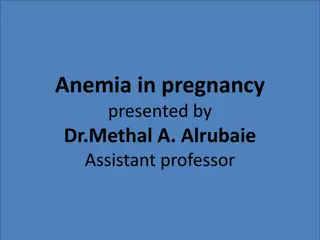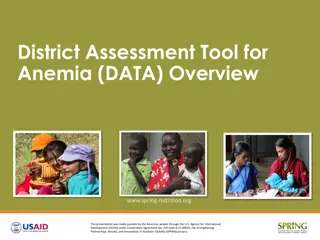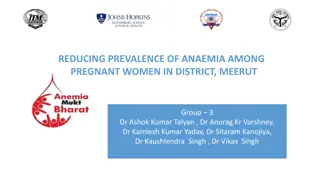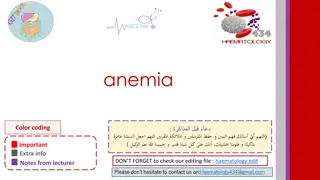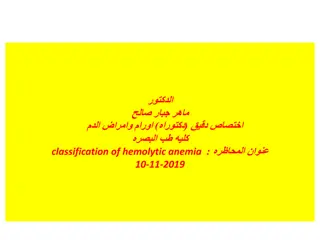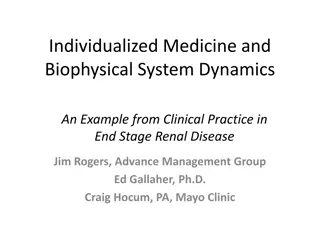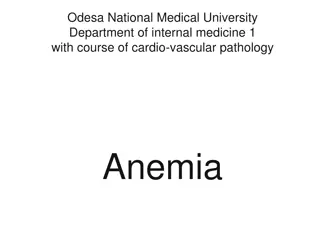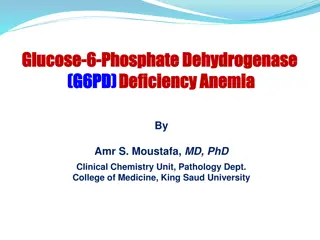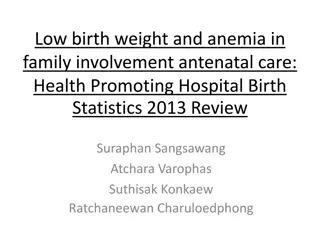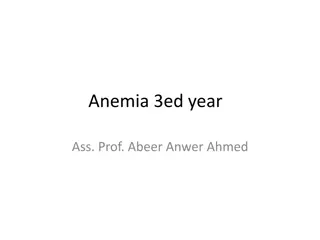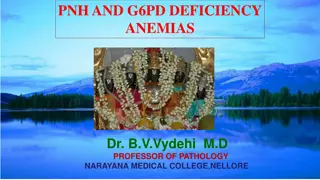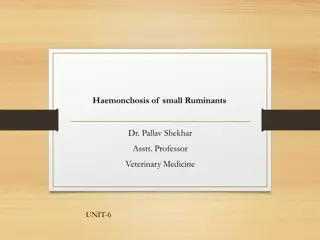Understanding Clinical Features of Anemia
Clinical features of anemia include cardiovascular adaptations, variations in symptom presentation based on speed and severity of onset, implications of age, and changes in the hemoglobin-O2 dissociation curve. Symptoms may range from breathlessness and weakness to cardiac issues, while signs like pallor and hyperdynamic circulation can be observed. Identifying and understanding these aspects are crucial for diagnosing and managing anemia effectively.
Download Presentation

Please find below an Image/Link to download the presentation.
The content on the website is provided AS IS for your information and personal use only. It may not be sold, licensed, or shared on other websites without obtaining consent from the author. Download presentation by click this link. If you encounter any issues during the download, it is possible that the publisher has removed the file from their server.
E N D
Presentation Transcript
general aspects of anaemia Ass.prof.Abeer Anwer
Clinical features of anaemia The major adaptations to anaemia are in the cardiovascular system (with increased stroke volume and tachycardia) and in the haemoglobin O2 dissociation curve. In some patients with quite severe anaemia there may be no symptoms or signs, whereas others with mild anaemia may be severely incapacitated.
The presence or absence of clinical features can be considered under four major headings 1. Speed of onset Rapidly progressive anaemia causes more symptoms than anaemia of slow onset because there is less time for adaptation in the cardiovascular system and in the O2 dissociation curve of haemoglobin. 2. Severity Mild anaemia often produces no symptoms or signs but these are usually present when the haemoglobin is less than 90 g/L. Even severe anaemia (haemoglobin concentration as low as 60 g/L) may produce remarkably few symptoms, when there is very gradual onset in a young subject who is otherwise healthy.
3. Age The elderly tolerate anaemia less well than the young because normal cardiovascular compensation is impaired. 4. Haemoglobin O2dissociation curve Anaemia, in general, is associated with a rise in 2,3 DPG in the red cells and a shift in the O2 dissociation curve to the right so that oxygen is given up more readily to tissues. This adaptation is particularly marked in some anaemias that either raise 2,3 DPG directly (e.g. pyruvate kinase deficiency or that are associated with a low affinity haemoglobin (e.g. Hb S)
Symptoms If the patient does have symptoms these are usually shortness of breath, particularly on exertion, weakness, lethargy, palpitation and headaches. In older subjects, symptoms of cardiac failure, angina pectoris or intermittent claudication or confusion may be present. Visual disturbances because of retinal haemorrhages may complicate very severe anaemia, particularly of rapid onset
Signs These may be divided into general and specific. General signs: include pallor of mucous membranes or nail beds, which occurs if the haemoglobin level is less than 90 g/L Conversely, skin colour is not a reliable sign. A hyperdynamic circulation may be present with tachycardia, a bounding pulse, cardiomegaly and a systolic flow murmur especially at the apex. Particularly in the elderly, features of congestive heart failure may be present.
Specific signs are associated with particular types of anaemia, e.g. koilonychia (spoon nails) with iron deficiency, jaundice with haemolytic or megaloblastic anaemias, leg ulcers with sickle cell and other haemolytic anaemias, bone deformities with thalassaemia major. The association of features of anaemia with excess infections or spontaneous bruising suggest that neutropenia or thrombocytopenia may be present, possibly as a result of bone marrow failure.
Classification and laboratory findings in anaemia Red cell indices The most useful classification is that based on red cell indices and divides the anaemia into: microcytic, normocytic and macrocytic . As well as suggesting the nature of the primary defect, this approach may also indicate an underlying abnormality before overt anaemia has developed. In two common physiological situations, the mean corpuscular volume (MCV) may be outside the normal adult range. In the newborn for a few weeks the MCV is high but in infancy it is low (e.g. 70 fL at 1 year of age) and rises slowly throughout childhood to the normal adult range. In normal pregnancy there is a slight rise in MCV, even in the absence of other causes of macrocytosis (e.g. folate deficiency).
Morphological Classification Anemia Macrocytic Normocytic Microcytic Genetic Anomaly Megaloblastic Non-megaloblastic IDA 1. 2. Hepatic disease Drug-induced anemia Hypothyroidism Reticulocytosis 1. Vitamin B12 deficiency Folic acid deficiency 1. 2. Sickle cell Thalassemia 1. 2. 3. 4. Recent blood loss Hemolysis Bone marrow failure Anemia of chronic disease 2. 3. 4.
Other laboratory findings Although the red cell indices will indicate the type of anaemia, further useful information can be obtained from the initial blood sample. Leucocyte and platelet counts Measurement of these helps to distinguish pure anaemia from pancytopenia (subnormal levels of red cells, neutrophils and platelets), which suggests a more general marrow defect or destruction of cells (e.g. hypersplenism). In anaemias caused by haemolysis or haemorrhage, the neutrophil and platelet counts are often raised; In infections and leukaemias, the leucocyte count is also often raised and there may be abnormal leucocytes or neutrophil precursors present.
Reticulocyte count The normal percentage is 0.5 2.5%, and the Ab solutecount 50 150 109/L This should rise in anaemia because of erythropoietin increase, and be higher the more severe the anaemia. This is particularly so when there has been time for erythroid hyperplasia to develop in the marrow as in chronic haemolysis. After an acute major haemorrhage there is an erythropoietin response in 6 hours, the reticulocyte count rises within 2 3 days, reaches a maximum in 6 10 days and remains raised until the haemoglobin returns to the normal level. If the reticulocyte count is not raised in an anaemic patient this suggests impaired marrow function or lack of erythropoietin stimulus
Factors impairing the normal reticulocyte response to anaemia. Marrow diseases, e.g. hypoplasia, infiltration by carcinoma, lymphoma, myeloma, acute leukaemia, tuberculosis Deficiency of iron, vitamin B12 or folate Lack of erythropoietin, e.g. renal disease Reduced tissue O2 consumption, e.g. myxoedema, protein deficiency Ineffective erythropoiesis, e.g. thalassaemia major, megaloblastic anaemia, myelodysplasia, myelofibrosis Chronic inflammatory or malignant disease
Blood film It is essential to examine the blood film in all cases of anaemia. Abnormal red cell morphology or red cell inclusions. may suggest a particular diagnosis. During the blood film examination, white cell abnormalities are sought, platelet number and morphology are assessed and the presence or absence of abnormal cells (e.g. normoblasts, granulocyte precursors or blast cells) is noted.
Bone marrow examination This is needed when the cause of anaemia or other abnormality of the blood cells cannot be diagnosed from the blood count, film and other blood tests alone. It may be performed by aspiration or trephine biopsy
The detail of the developing cells can be examined (e.g. normoblastic or megaloblastic), the proportion of the different cell lines assessed (myeloid : erythroid ratio, the proportion of granulocyte precursors to red cell precursors in the bone marrow, normally 2.5 : 1 to 12 : 1), and the presence of cells foreign to the marrow (e.g. secondary carcinoma) observed. The cellularity of the marrow can also be viewed provided fragments are obtained. An iron stain is performed routinely so that the amount of iron in reticuloendothelial stores (macrophages) and as fine granules ( siderotic granules) in the developing erythroblasts can be assessed. An aspirate sample may also be used for a number of other specialized investigations
A trephine biopsy provides a solid core of bone including marrow and is examined as a histological specimen after fixation in formalin, decalcification and sectioning. Usually immunohistology is performed depending on the diagnosis suspected A trephine biopsy specimen is less valuable than aspiration when individual cell detail is to be examined but provides a panoramic view of the marrow from which overall marrow architecture, cellularity and presence of fibrosis or abnormal infiltrates can, with immunohistology, be reliably determined.
Ineffective erythropoiesis Erythropoiesis is not entirely efficient because approximately 10 15% of developing erythroblasts die within the marrow without producing mature cells. This is termed ineffective erythropoiesis and it is substantially increased in a number of chronic anaemias . The serum unconjugated bilirubin (derived from breaking down haemoglobin) and lactate dehydrogenase (LDH, derived from breaking down cells) are usually raised when ineffective erythropoiesis is marked. The reticulocyte count is low in relation to the degree of anaemia and to the proportion of erythroblasts in the marrow.
Assessment of erythropoiesis Total erythropoiesis and the amount of erythropoiesis that is effective in producing circulating red cells can be assessed by : Examining the bone marrow, haemoglobin level and reticulocyte count. Total erythropoiesis is assessed from the marrow cellularity and the myeloid : erythroid ratio.This ratio falls and may be reversed when total erythropoiesis is selectively increased. Effective erythropoiesis is assessed by the reticulocyte count. This is raised in proportion to the degree of anaemia when erythropoiesis is effective, but is low when there is ineffective erythropoiesis or an abnormality preventing normal marrow response


